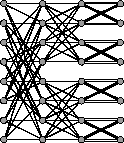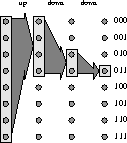Butterfly and dilated butterfly networks belong to a larger class of
networks that are often referred to as splitter networks. The
switches on each level of a splitter network can be partitioned into
blocks. All of the switches on level 0 belong to the same
block. On level 1, there are two blocks, one consisting of the
switches that are in the upper ![]() rows, and the other consisting of
the switches that are in the lower
rows, and the other consisting of
the switches that are in the lower ![]() rows. In general, the
switches in a block B of size
rows. In general, the
switches in a block B of size ![]() on level l have neighbors
in two blocks,
on level l have neighbors
in two blocks, ![]() and
and ![]() , on level l+1, where u stands for
upper and l for lower. The upper block,
, on level l+1, where u stands for
upper and l for lower. The upper block, ![]() ,
contains the switches on level l+1 that are in the same rows as the
upper
,
contains the switches on level l+1 that are in the same rows as the
upper ![]() switches of B. The lower block,
switches of B. The lower block, ![]() , consists of the
switches that are in the same rows as the lower
, consists of the
switches that are in the same rows as the lower ![]() switches of B.
The edges from B to
switches of B.
The edges from B to ![]() are called the up edges, and those
from B to
are called the up edges, and those
from B to ![]() are called the down edges. The three
blocks, B,
are called the down edges. The three
blocks, B, ![]() , and
, and ![]() , and the edges between them are
collectively called a splitter. The switches in B are called
the splitter inputs, and those in
, and the edges between them are
collectively called a splitter. The switches in B are called
the splitter inputs, and those in ![]() and
and ![]() are called the
splitter outputs. In a splitter network with
multiplicity d, each splitter input is incident to d outgoing
up edges and d outgoing down edges, and each splitter output is
incident to 2d incoming edges. In a d-dilated butterfly, the d
up (and d down) edges incident to each splitter input all lead to the
same splitter output, but this need not be the case in general. For
example, we have illustrated an 8-input splitter network with
multiplicity 2 in Figure 2.
are called the
splitter outputs. In a splitter network with
multiplicity d, each splitter input is incident to d outgoing
up edges and d outgoing down edges, and each splitter output is
incident to 2d incoming edges. In a d-dilated butterfly, the d
up (and d down) edges incident to each splitter input all lead to the
same splitter output, but this need not be the case in general. For
example, we have illustrated an 8-input splitter network with
multiplicity 2 in Figure 2.

Figure 2: An
8-input splitter network with multiplicity 2.
In a splitter network, each input and output are connected by a single logical (up-down) path through the blocks of the network. For example, Figure 3 shows the logical path from any input to output 011. In a butterfly, this logical path specifies a unique path through the network, since only one up and one down edge emanate from each switch. (In fact, a splitter network with multiplicity one is very similar to a delta network [17].) In a general splitter network with multiplicity d, however, each switch will have d up and d down edges, and each step of the logical path can be taken on any one of d edges. Hence, one logical path can be realized by a myriad of physical paths in a general splitter network.

Figure 3: The logical path from any input
to output 011.